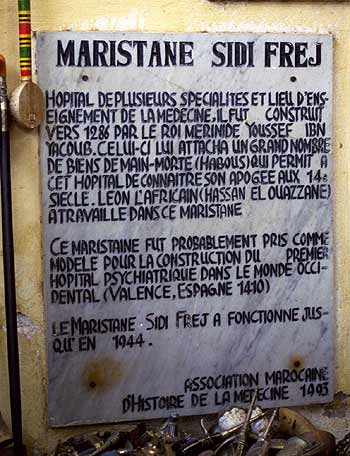|
|
|
|
Le Maristane- an ancient Insane Asylum In downtown Fes, on the far side of a small courtyard that is now famous for its Henne Souk, lies a building with the following inscription: 
The plaque was installed by the Moroccan association of Medical history in 1993. Today, the Maristane is home to a set of linen stalls and other small businesses, though it retains much of its courtyard feel, and one can still see the many rooms which used to host patients. But the rowdy inhabitants that once inhabited this ancient hospital have been moved outside the medina, into the new parts of town. There is now a new Psychiatric hospital in Fes- it was inaugurated by Mohammed V in 1947 (or so says a Fassi I met on a train...). Eager to gather more information on Leo, I asked different business attendants and local wanderers if they knew who Leo was- most were confused by my question, though some proved innovative in their confusion. One invented Leo's past and significance: he was a doctor, a famous one, the first and greatest doctor in Morocco (not bad for a hypothesis, given that the building once was a hospital). Another proved more cautious and took the time to read the Arabic version of the plaque- triumphantly he stated that Leo once worked as a scribe for the hospital. And he was right…. Here are Leo's own words:
Leo displays
his knowledge of the place by further describing the hospital, the
ways in which patients were treated and the stories that were told
around and about the place.
The following story/myth is particularly detailed, suggesting that
Leo may have been witness to such a scene, or heard it directly from
a witness.
The fact that he should generalize this event into a normal behavior for all patients in the hospital is yet another example of Leo's very 'biographical' way of writing history. Leo bases both the content and the legitimacy of his work on 'first hand experience'; for him there are no better facts than the ones he has actually observed. This 'subjective' path to history/cultural geography sometimes leads to odd generalizations about people and places! |
|||||||